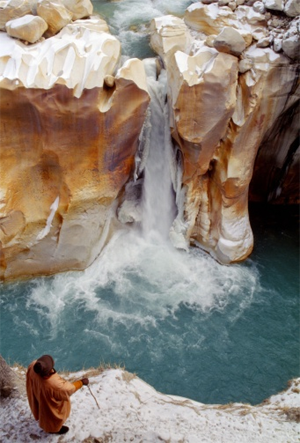|
By plucking her petals you do not gather
the beauty of the flower
—The Stray Birds by Rabindranath Tagore
Who can resist the charm of the rain scene in Satyajit Ray’s Pather Panchali, or Kumar Gandharva’s exposition of rag Miyan-ki-Malhar in the composition “bol re papihara” . . . the super fast taans cascading down in sheer vigour and vitality?
The architect’s sense of design,
the dancer’s skill in abhinaya,
the actor’s passion for drama,
the writer’s search for akshara,
the film director’s making of a shot.
To this, add every artiste’s search for space . . . and imagine the king of seasons - Varsha Ritu’s play in all these images!
Rains have always caught our fancy and our imagination. Haiku being rooted in seasons and nature, it is not surprising at all that we try to capture the magic of this monsoon season in our little poems, bringing out the various rasas.
In Japanese haikai traditions, along with the four regular seasons of Summer, Autumn, Winter and Spring, we see “New Year” as an additional fifth seasonal reference.
 When I entered the haiku world, in mid 2005, I realised that Indians do respect the classical traditions connecting to seasons and all our art forms adhere to this six season classification, making Varsha Ritu one of the most important seasons. Gabi Greve (A German who lives in Japan) had by that time started to collect the season words of the world and I volunteered to help out in finding Indian “kigo words” (which means season words in Japanese) and suggested that we begin with India’s six seasons. When I entered the haiku world, in mid 2005, I realised that Indians do respect the classical traditions connecting to seasons and all our art forms adhere to this six season classification, making Varsha Ritu one of the most important seasons. Gabi Greve (A German who lives in Japan) had by that time started to collect the season words of the world and I volunteered to help out in finding Indian “kigo words” (which means season words in Japanese) and suggested that we begin with India’s six seasons.
Haiku along with its genres like tanka and haibun are nothing but word paintings. In film jargon we could refer to it as “a shot” frozen in time. So in a poem comprising of just six or seven words, resonance becomes the key word!
Anu-naad is a Sanskrit word for resonance . . .
now what do we mean by Anu-naad?
Naad or sound, as stated in the Hindu ancient texts is a primordial sound existing in the cosmos, referred to metaphorically as AUM. According to ancient texts, an instrument (such as the voice) only resonates the cosmic sound, and thus all that the body does is to extricate the sound from the cosmos and faithfully reproduce it, when a person sings or talks. The cavities in the body - like the oral cavity and the sinus cavities – including the spaces from the toes to the brain, all act as resonators or amplifiers for the ‘sound’ to vibrate and reverberate, which in Sanskrit is called as Anu-Naad. In other words, like Saint poet Kabir has rightly expressed in a spiritual song, that, his body is only a musical instrument that transmits the timeless cosmic resonance.
wave-calls
haunting melodies linger
in mind’s abyss
I’ve just picked out a few poems, in reference to this season, from my poems spanning haiku, tanka and haibun. Each poem tells a story, if only you care to peep and stay with the spaces within the words, for a while . . .
Haiku
cyclonic rains
coconut leaves dip
into streetlights
thunderclap
the darkening sky splits
into liquid night
neighbour’s tin roof
what a ruckus it creates
this rain!
swamp frogs . . .
singing the chorus
all over again
water buffaloes . . .
shoreline shadows pleat
the monsoon lake
cyclone
she holds the umbrella
the sari holds her
bus ride in monsoon
a snoring man’s head bounces
at the pothole
temple bells -
the isolated raindrops
on my umbrella
she looks down
from the ninth floor apartment:
umbrellas with legs
midnight jetty
the sound of water
slapping water
tapering monsoon
from different sides of the hill
sound of cow-bells
Tanka
Ganga
melting from glaciers
becomes
the waterness of water...
I take the holy dip
the ganga rumbling
through mountains and plains
joins the ocean . . .
the weight of my womb
even after menopause
rain catchers
near our banyan tree
here and there
leaves of the pond lotus
roll raindrop-moons
illusions ride
on a fast fading rainbow
somewhere there
I let go of my childhood . . .
I must have
Haibun
 Gangotri Gangotri
The Ganga — called the Bhagirathi at Uttarkashi — flows down the Himalayan range. We hear her through the day and through the night. We’re staying in a small cottage, up somewhere hidden amongst the trees.
The owner is a middle-aged man who was brought up in these hills. He learnt mountaineering as a young child from his father, before it became a professional course in colleges, he proudly claims. He tells us that there is a Sanskrit quote which talks about the Ganga playing hide and seek with the mountains - here now, gone the next moment into a crevice, only to appear far away, continuing with her water song.
from the horizon
the rhythm of waves —
Stray Birds
From where we are talking, I look down. The Ganga in monsoon is in fearsome form, she roars and fumes down the mountains. To think she is that same gentle girl we see on Lord Shiva's matted hair-lock, when, to subdue her fury, he had pinned her down — a story our grandmothers often told us.
fireflies
in their own world
jasmine rain
Notes: Gangotri, a town in the state of Uttarakhandd, India, is a site of Hindu pilgrimage on the banks of the river Bhagirathii. Stray Birds —Rabindranath Tagore’s famous book of short haiku-like poems
The Afterglow
Unending rains, the hills are green all over.
In my balcony, the champa is soaked in fragrance, her edges frayed.
I dread the monsoon slush— my each step grounded in the grip of my flip-flops. Even more, I dread to be on roads that run past me . . .
I’m housebound I am.
Period.
Just for a while, the caged mind begins to rake up pleasant memories, then stealthily steps on those sunken ruts. Headlong I'm thrown into the unfathomable depths of old hurts and wounds, and then those soothing licks that heal, sort of . . . the talking inward poet weaves in and out of breath.
afterglow . . .
the old basement clock
strikes the hour again
First published in Muse India – July 2012
Excepting a few, the poems above have been published in leading journals: online, print editions and anthologies. I thank the editors of: Acorn, A Hundred Gourds, Contemporary Haibun Online (CHO), Haibun Today, Magnapoets, Mainichi Daily News, Modern Haiku, Notes From The Gean, Presence Haiku Journal, Roadrunner Haiku Journal, Simply Haiku, The Heron’s Nest and 3 light’s Gallery.
Images (c) Gettyimages.com
|